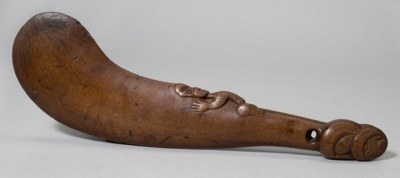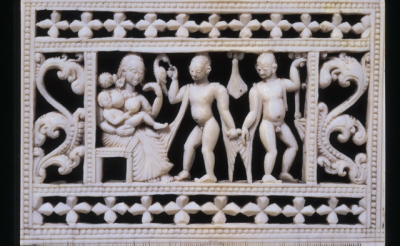To search the RPR site click here
CATALOGUE OF THE ANTHROPOLOGICAL COLLECTION LENT BY COLONEL LANE FOX FOR EXHIBITION IN THE BETHNAL GREEN BRANCH OF THE SOUTH KENSINGTON MUSEUM, JUNE 1874
Preface to Parts I and II
As the first two parts of this Catalogue are to be published before the remaining portion is completed [N.B. the remaining parts were never completed or published], it appears desirable to say a few words explanatory of the system upon which the collection has been arranged, reserving a more comprehensive introduction until the whole is finished. Most of the objects exhibited are such as may be found in many ethnological museums, and it is only in relation to their psychological and sociological bearings that I venture to think some improvement may be found to have been introduced into the method of exhibiting them.
The objects are arranged in sequence with a view to show, in so far as the very limited extent of this collection renders such demonstration practicable, the successive ideas by which the minds of men in a primitive condition of culture have progressed in the development of their arts from the simple to the complex, and from the homogeneous to the heterogeneous.
Evolution and development are terms which, it is now beginning to be admitted, are as applicable to the progress of humanity as to all other mundane affairs. Anthropology, according to the more usual acceptation of the term, deals with the whole history of human development, and may be divided into two main branches. The first relates to the constitution of man, in which we have to do with man as a member of the animal kingdom, his mental and physical faculties and peculiarities, the varieties of race, the influence of heredity, and so forth. The second division may be classed under the head of culture, in which we deal with a new order of things, the origin of which was coeval with the first appearance of man upon the earth, no other animal being capable of self culture in the proper sense of the term. Up to this point the development of species has gone on in accordance with the laws of procreation and natural selection. Man being the last product of this order of things, becomes capable by means of his intellect of modifying external nature to his wants, and from henceforth we have to concern ourselves with a series of developments produced by art.
It is the province of anthropology to trace back the sequence of these developments to their sources. In the more restricted sense of the term anthropology, it appears to be applied by some to the first only of these two divisions of the subject, whilst the second, or that which I here term culture, has been recognised under the appellation of sociology or social science. It matters little which term is employed, provided we keep the two ideas distinct in our minds.
Human ideas, as represented by the various products of human industry, are capable of classification into genera, species and varieties in the same manner as the products of the vegetable and animal kingdoms, and in their development from the homogeneous to the heterogeneous they obey the same laws. If, therefore, we can obtain a sufficient number of objects to represent the succession of ideas, it will be found that they are capable of being arranged in museums upon a similar plan.
The classification of natural history specimens has long been a recognised necessity in the arrangement of every museum which professes to impart useful information. But ethnological specimens have not generally been thought capable of anything more than a geographical classification. This arises mainly from sociology not having until recently been recognised as a science, if, indeed, it can be generally accepted as such at the present time. Travellers, as a rule, have not yet embraced the idea, and consequently the specimens in our museums, not having been systematically collected, cannot be scientifically arranged. They consist of miscellaneous objects brought home as reminiscences of travel or of such as have been most easily procured by sailors at the sea-ports. Unlike natural history specimens which have for years past been selected with a view to variety, affinity, and sequence, these ethnologicalcuriosities have been selected without any regard to their history or psychology, and although they would be none the less valuable for having been selected without influence from the bias of preconceived theories, yet, not being supposed capable of any scientific interpretation, they have not been obtained in sufficient number or variety to make classification possible.
Since 1852 I have endeavoured to overcome this difficulty by selecting from amongst the commoner class of objects which have been brought to this country those which appear to show connexion in form. Whenever missing links have been found they have been added to the collection, and the result has been to establish, however imperfectly, sequence in several series.
I had already accumulated a considerable number of objects upon this plan when I first became acquainted with the more extensive and valuable collection of Mr. Henry Christy, which, however, at that time was confined chiefly to pre-historic specimens, in which field of research he had himself contributed important discoveries; since then, and subsequently to his death, his collection has extended to objects illustrating the industry of modern savages.
The utility of two collections embracing the same class of objects might not be very apparent were it not for the different method upon which the specimens have been collected and arranged. In the Christy Collection the primary arrangement is geographical, whereas I have from the first collected and arranged by form. The result has been that different points of interest have been brought to light. Both systems have their advantages and disadvantages, by a geographical arrangement the general culture of each distinct race is made the prominent feature of the collection, and it is therefore more strictly ethnological, whereas in the arrangement which I have adopted the development of specific ideas, and their transmission from one people to another, is made more apparent, and it is therefore of greater sociological interest.
Acting upon the principle of reasoning from the known to the unknown I have commenced this catalogue with the specimens of the arts of existing savages, and have employed them as far as possible to illustrate the relics of primeval men, none of which, except those constructed of, the more imperishable materials, such as flint and stone, have survived to our time. All the implements of primeval man that were of decomposable materials having disappeared, can be replaced only in imagination by studying those of his nearest congener, the modern savage.
To what extent the modern savage actually represents primeval man is one of those problems which anthropology is called upon to solve. That he does not truly represent him in all particulars we may be certain. Analogy would lead us to believe that he presents us with a traditional portrait of him rather than a photograph. The resemblance between the arts of modern savages and those of primeval man may be compared to that existing between recent and extinct species of animals. As we find amongst existing animals and plants species akin to what geology teaches us were primitive species, and as among existing species we find the representatives of successive stages of geological species, so amongst the arts of existing savages we find forms which, being adapted to a low condition of culture, have survived from the earliest times, and also the representatives of many successive stages through which development has taken place in times past. As amongst existing animals and plants these survivals from different ages give us an outline picture of a succession of gradually improving species, but do not represent the true sequence by which improvement has been effected, so amongst the arts of existing people in all stages of civilisation we are able to trace a succession of ideas from the simple to the complex, but not the true order of development by which those more complex arrangements have been brought about. As amongst existing species of animals innumerable links are wanting to complete the continuity of structure, so amongst the arts of existing peoples there are great gaps which can only be filled by pre-historic arts. What the palaeontologist does for zoology, the pre-historian does for anthropology. What the study of zoology does towards explaining the structures of extinct species, the study of existing savages does towards enabling us to realise the condition of primeval man.
This analogy holds good in the main, though there are points of difference which greatly complicate the human problem, and which cannot be entered into in this brief summary of the subject.
The importance of studying the material arts of savages and pre-historic men is evident, when it is considered that they afford us the most reliable evidence by which to trace their history and affinities. It has been said that language is the surest test of race. This is true of an advanced state of culture, in which language has attained persistency, and still more so where it has been committed to writing; but it is certainly not true of the lowest savages, amongst whom language changes so rapidly that even neighbouring tribes are unable to understand one another; and if this is the case in respect to language, still more strongly does it apply to all ideas that are communicated by word of mouth. In endeavouring to trace back the history of the arts to their root forms we find that in proportion as the value of language and of the ideas conveyed by language diminishes, that of ideas embodied in material forms increases in stability and permanence. Whilst in the earliest phases of humanity the names for things change with every generation, if not more frequently, the things themselves are handed down unchanged from father to son and from tribe to tribe, and many of them have continued to our own time faithful records of the conditions of the people by whom they were fabricated.
In concluding this preface I cannot do better than refer the reader to the recently published work of Mr. Herbert Spencer on the study of sociology, and more particularly to that portion of it which relates to the difficulties of social science arising from the automorphic interpretation of the works of people in a very different state of culture to our own. To this cause must be attributed chiefly the difficulty which we experience in realising the very slow stages by which progress has been effected during the earliest periods of the human race.
A. Lane Fox, Guildford, May 1874.
To read a draft copy of part of this introduction go here.
[Transcribed as part of the Kent project in the 1990s by AP]





